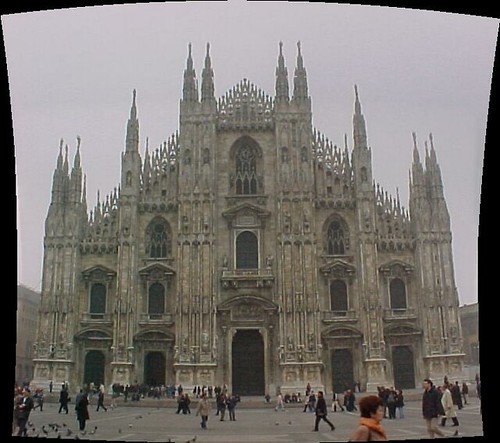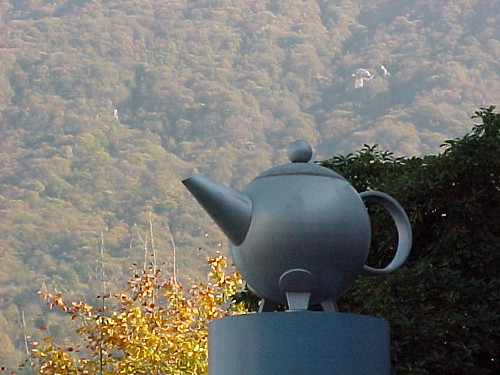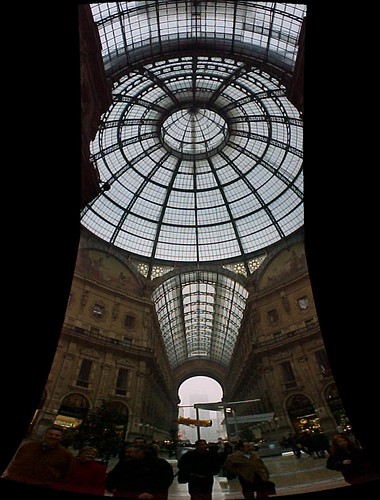Sunday 11 November 2001
Leaning Tower of Pisa, Pisa
Although intended to stand vertically, the tower began leaning to the southeast soon after the onset of construction in 1173 due to a poorly laid foundation and loose substrate that has allowed the foundation to shift direction. The tower presently leans to the southwest.
Leaning Tower of Pisa, Pisa
The Leaning Tower of Pisa (Italian: Torre pendente di Pisa) or simply The Tower of Pisa (La Torre di Pisa) is the campanile, or freestanding bell tower, of the cathedral of the Italian city of Pisa. It is situated behind the cathedral and is the third oldest structure in Pisa's Piazza del Duomo (Cathedral Square) after the cathedral and the baptistry.
Although intended to stand vertically, the tower began leaning to the southeast soon after the onset of construction in 1173 due to a poorly laid foundation and loose substrate that has allowed the foundation to shift direction. The tower presently leans to the southwest.
Monday 5 November 2001
Milan Cathedral (Duomo di Milano), Milano, Italy
Milan's layout, with streets either radiating from the Duomo or circling it, reveals that the Duomo occupies the most central site in Roman Mediolanum, that of the public basilica facing the forum. Saint Ambrose's 'New Basilica' was built on this site at the beginning of the 5th century, with an adjoining basilica added in 836. When a fire damaged both buildings in 1075, they were rebuilt as the Duomo.
Milan Cathedral (Duomo di Milano), Milano, Italy
Milan Cathedral (Italian: Duomo di Milano; Milanese: Domm de Milan) is the cathedral church of Milan in Lombardy, northern Italy. It is the seat of the Archbishop of Milan, currently Cardinal Dionigi Tettamanzi.
Milan's layout, with streets either radiating from the Duomo or circling it, reveals that the Duomo occupies the most central site in Roman Mediolanum, that of the public basilica facing the forum. Saint Ambrose's 'New Basilica' was built on this site at the beginning of the 5th century, with an adjoining basilica added in 836. When a fire damaged both buildings in 1075, they were rebuilt as the Duomo.
Sunday 4 November 2001
Alessi factory, Crusinallo, Italy
Alberto Alessi, Giovanni's grandson, has been heading the company since 1970. He has been credited for recruiting some of the best and most well-known designers to contribute their designs to Alessi's stable of products. These designers include Ettore Sottsass, Richard Sapper, Achille Castiglioni, Michael Graves, Aldo Rossi, and Philippe Starck. It was also Alberto who was responsible for Alessi’s move beyond metalwork to produce designs in ceramic, wood, and plastic. Who else but Alessi would commission Philippe Starck to design a plastic fly-swatter, Dr. Fly, turning an old-fashioned and obscure object into a design status symbol?
Alessi factory, Crusinallo, Italy
Founded in 1921, Alessi has become a renown purveyor of hip, elegant utensils. Combining the slickness of mechanized production with a tradition of skilled, labor-intensive work, Alessi fulfilled the needs and dreams of many design-conscious kitchen owners. Located in the town of Crusinallo, an hour drive from Milan, the Alessi factory is in a region of Italy recognized for its metalwork since the 17th century. Alessi has been a venerable member of that tradition ever since Giovanni Alessi first opened its factory doors.
Alberto Alessi, Giovanni's grandson, has been heading the company since 1970. He has been credited for recruiting some of the best and most well-known designers to contribute their designs to Alessi's stable of products. These designers include Ettore Sottsass, Richard Sapper, Achille Castiglioni, Michael Graves, Aldo Rossi, and Philippe Starck. It was also Alberto who was responsible for Alessi’s move beyond metalwork to produce designs in ceramic, wood, and plastic. Who else but Alessi would commission Philippe Starck to design a plastic fly-swatter, Dr. Fly, turning an old-fashioned and obscure object into a design status symbol?
Saturday 3 November 2001
Galleria Vittorio Emanuele II, Milan
The street is covered over by an arching glass and cast iron roof, a popular design for nineteenth-century arcades, such as the Burlington Arcade, London, which was the prototype for larger glazed shopping arcades, beginning with the Saint-Hubert Gallery in Brussels (opened 1847) and the Passazh in St Petersburg, (opened 1848) and including the Galleria Umberto in Naples (opened 1890).
The central octagonal space is topped with a glass dome. The Milanese Galleria was larger in scale than its predecessors and was an important step in the evolution of the modern glazed and enclosed shopping mall, of which it was the direct progenitor. It has inspired the use of the term galleria for many other shopping arcades and malls.
The Galleria connects two of Milan's most famous landmarks: The Duomo and the Teatro Alla Scala.
More than 120 years after its inauguration, the four-story arcade includes elegant shops selling most things from haute couture to books, as well as restaurants, cafés and bars. Directly connected to the Galleria Vittorio Emanuele II is Milan's ultra-luxurious Town House Galleria hotel, offering the city's most luxurious (and most expensive) rooms and facilities.
The Galleria is the site for many luxury goods' shops, like Gucci, Prada, Louis Vuitton.
Galleria Vittorio Emanuele II, Milan
The Galleria Vittorio Emanuele II is a covered double arcade formed of two glass-vaulted arcades at right angles intersecting in an octagon; it is prominently sited on the northern side of the Piazza del Duomo in Milan, and connects to the Piazza della Scala. Named after Vittorio Emanuele II, the first king of united Italy, it was originally designed in 1861 and built by Giuseppe Mengoni between 1865 and 1877.
The street is covered over by an arching glass and cast iron roof, a popular design for nineteenth-century arcades, such as the Burlington Arcade, London, which was the prototype for larger glazed shopping arcades, beginning with the Saint-Hubert Gallery in Brussels (opened 1847) and the Passazh in St Petersburg, (opened 1848) and including the Galleria Umberto in Naples (opened 1890).
The central octagonal space is topped with a glass dome. The Milanese Galleria was larger in scale than its predecessors and was an important step in the evolution of the modern glazed and enclosed shopping mall, of which it was the direct progenitor. It has inspired the use of the term galleria for many other shopping arcades and malls.
The Galleria connects two of Milan's most famous landmarks: The Duomo and the Teatro Alla Scala.
More than 120 years after its inauguration, the four-story arcade includes elegant shops selling most things from haute couture to books, as well as restaurants, cafés and bars. Directly connected to the Galleria Vittorio Emanuele II is Milan's ultra-luxurious Town House Galleria hotel, offering the city's most luxurious (and most expensive) rooms and facilities.
The Galleria is the site for many luxury goods' shops, like Gucci, Prada, Louis Vuitton.
Friday 2 November 2001
Gabriele D'Annunzio's S.V.A. 5 biplane, Cristoforo Colombo Airport, Genoa

Gabriele D'Annunzio's biplane, Cristoforo Colombo Airport, Genoa, originally uploaded by Craig Grobler.
The S.V.A. 5 was a fairly standard-looking biplane, its most recognizable features being the "W" shaped wing struts and the boxy, tapered fuselage that flattened out and practically merged with the tail fin. Powered by a 220-hp SPA 6A engine, it was fast enough and capable enough to take on multiple roles: bombing, reconnaissance, and fighting. It was of conventional fabric-covered wood construction.
Early Italian biplanes, such as the Savola-Pomillo, were unsuccessful. In 1916, designers Umberto Savola, Rodolfo Verduzio, and Celestino Rosatelli started from scratch, and laid out a new aircraft. Societa Ansaldo of Genoa and Turin, "Ansaldo," got the contract to build the planes and started in the prototype in December, 1916. After modifications to the radiator and the tail, the Ansaldo's workers at the Borzoli Mare factory, under director Brezzi, finished the first machine in March, 1917.
Gabriele D'Annunzio's S.V.A. 5 biplane, Cristoforo Colombo Airport, Genoa

Gabriele D'Annunzio's biplane, Cristoforo Colombo Airport, Genoa, originally uploaded by Craig Grobler.
Across the Carnic Alps, the self-styled warrior-poet Gabriele d'Annunzio, flew with eleven Ansaldo biplanes of the 87a Squadriglia, in a dramatic long-distance bombing raid on Vienna, August 9, 1918. They arrived over the ancient capital of the Hapsburgs and rained down a lethal storm of ... leaflets ... encouraging the Viennese to go on strike.
The S.V.A. 5 was a fairly standard-looking biplane, its most recognizable features being the "W" shaped wing struts and the boxy, tapered fuselage that flattened out and practically merged with the tail fin. Powered by a 220-hp SPA 6A engine, it was fast enough and capable enough to take on multiple roles: bombing, reconnaissance, and fighting. It was of conventional fabric-covered wood construction.
Early Italian biplanes, such as the Savola-Pomillo, were unsuccessful. In 1916, designers Umberto Savola, Rodolfo Verduzio, and Celestino Rosatelli started from scratch, and laid out a new aircraft. Societa Ansaldo of Genoa and Turin, "Ansaldo," got the contract to build the planes and started in the prototype in December, 1916. After modifications to the radiator and the tail, the Ansaldo's workers at the Borzoli Mare factory, under director Brezzi, finished the first machine in March, 1917.



